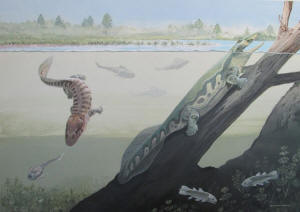|
South African fossils rewrite early
history of life on land
 Send a link to a friend
Send a link to a friend
 [June 09, 2018]
By Will Dunham [June 09, 2018]
By Will Dunham
WASHINGTON (Reuters) - Fossils of two
amphibians that lived within the Antarctic circle 360 million years ago
are forcing scientists to rethink the origins of land vertebrates,
including where these pioneers first appeared and the climatic
conditions that spawned them.
Scientists said on Thursday they have unearthed partial remains of
primitive Devonian Period amphibians named Tutusius umlambo and
Umzantsia amazana at a site called Waterloo Farm near Grahamstown, South
Africa.
While the fossils are fragmentary, the researchers said Tutusius and
Umzantsia most likely shared the four-legged,
alligator-crossed-with-a-fish body plan of the earliest amphibians,
eating small fish while in the water and perhaps small invertebrates
while on land.
Umzantsia was about 28 inches long (70 cm) with a long, slender lower
jaw, apparently armed with small pointed teeth. Tutusius, known from a
single shoulder girdle bone, was about a yard (meter) long. It was named
in honor of South African Anglican cleric and human rights activist
Desmond Tutu.
They were among the early wave of tetrapods, a group including all
land-living vertebrates. The first tetrapods evolved from fish during
the Devonian. Until now, it had been thought that this evolution
revolution occurred in warm climes because the fossils of all the
earliest-known amphibians, as well as their fish forerunners, had been
found in places that were tropical or subtropical at the time.
Africa during the Devonian was part of a super-continent called Gondwana
that also encompassed South America, India, Australia and Antarctica.
The Waterloo Farm site was within the Arctic circle.
"So we now know that tetrapods, by the end of the Devonian, lived all
over the world, from the tropics to the Antarctic circle," said
paleontologist Robert Gess, based at the Albany Museum in Grahamstown as
part of the South African Centre of Excellence in Palaeosciences,
centered at the University of the Witwatersrand.
[to top of second column]
|

Two newly discovered early amphibians Tutusius and Umzantsia that
lived about 360 million years ago during the Devonian Period whose
partial remains were unearthed at the Waterloo Farm site in South
Africa are shown in this artistís illustration, released June 7,
2018. Courtesy Maggie Newman/Handout via REUTERS

"So it's possible that they originated anywhere and that they could
have moved onto land anywhere. It really broadens the scope of
possibilities," Gess added.
The Waterloo Farm site was a river-mouth environment, a tidal
estuary opening onto the sea, and likely had a cold climate akin to
northern Norway's Atlantic coast, said paleontologist Per Ahlberg of
the University of Uppsala in Sweden.

"There would certainly have been several months of winter darkness,
as well as midnight sun in the summer," Ahlberg said, adding that it
probably snowed in wintertime.
The research was published in the journal Science.
(Reporting by Will Dunham; Editing by Sandra Maler)
[© 2018 Thomson Reuters. All rights
reserved.]
Copyright 2018 Reuters. All rights reserved. This material may not be published,
broadcast, rewritten or redistributed.
Thompson Reuters is solely responsible for this content. |